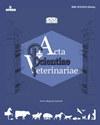Effects of Heat-Stress on Oocyte Number and Quality and In Vitro Embryo Production in Holstein Heifers
IF 0.2
4区 农林科学
Q4 VETERINARY SCIENCES
引用次数: 2
Abstract
Background: This study aimed to determine the effects of environmental temperature on the number and quality of oocytes and embryo production rates obtained by performing ovum pick up (OPU). Heat stress leads to long-term, short-term, visible, and invisible effects in dairy cows. Its effects on reproduction are evident in all stages, from oocyte development to birth. Disturbance in ovarian follicle development, follicular dominance deficiency, anoestrus, polyspermia, embryoniclosses, decreased fetal growth, and abortion are some examples of responses to these effects. The aim of the present study was aimed to determine the effects of ambient temperature on oocyte quality and number and embryo production rates.Materials, Methods & Results: The animal material used in this study comprised 10 Holstein heifers. At the beginning of the study, the heifers were 13-15 months old. OPU was performed at different times of the year, and weather conditions were recorded. Grouping according to ambient temperature was done as < 10°C (group 1), 10-25°C (group 2), and > 25°C (group 3). The veterinary ultrasonography device and a set of compatible intravaginal OPU probe, catheter, and aspiration device were used for OPU application. All antral follicles with diameters of 2-8 mm in the ovaries were aspirated. The aspirated follicle fluids were examined under a stereo microscope, and the cumulus-oocyte complexes (COC) were collected and classified according to their structure. A, B, and C-quality oocytes were included in the in vitro embryo production process. After performing 69 OPUs on random days of the cycle, the number of oocytes per OPU was found to be 8.72, 6.32, and 6.85 in groups 1, 2, and 3, respectively (P < 0.05). The number of viable oocytes per OPU was 6.83, 4.64, and 4.65 in groups 1, 2, and 3, respectively (P < 0.05). The statistical difference between the first group and the other groups was significant for cleavage and blastocyst counts (P < 0.05).Discussion: All the negative effects of heat stress on animals resulted from the increased body temperature. Reproductive performance is adversely affected by high temperatures and humidity during periods of high ambient temperatures. Metabolic heat is released, and the heat load increases due to the metabolism of nutrients in cattle. Internal body temperature is regulated via the dissipation of metabolic heat to the environment. The amount of heat dissipated via conduction andconvection depends on the unit body weight, surface area, skin and coat color, difference in temperature gradient of the animal and ambient temperature, and humidity. In the present study, it was determined that the blastocyst development rates of the oocytes obtained in the warm season (>25°C [group 3]) were lower than those of the other groups. It was concluded that this may be because the oocytes developed under chronic heat stress in the animals, and several cycles were required to enhance oocyte quality and developmental potential. Additional studies are needed to investigate the response of oocytes obtained with OPU to heat stress during embryonic developmental stages and to determine the sensitivity and effects of embryonic tissue damage according to developmental stages. Based on the results of the present study, it was concludedthat performing OPU and in vitro embryo production (IVEP) when the ambient temperature is close to the thermoneutral limits may increase the blastocyst development rates. Keywords: blastocyst, heat stress, heifer, in vitro embryo production, oocyte quality, ovum pick-up.热应激对荷斯坦小母牛卵母细胞数量、质量及体外胚胎生产的影响
背景:本研究旨在确定环境温度对卵母细胞数量和质量以及通过卵子采集(OPU)获得的胚胎生产率的影响。热应激会对奶牛产生长期、短期、可见和不可见的影响。它对生殖的影响在从卵母细胞发育到出生的各个阶段都很明显。卵泡发育障碍、卵泡优势缺失、无发情、多精子、胚胎丢失、胎儿生长迟缓和流产都是对这些影响的反应。本研究的目的是确定环境温度对卵母细胞质量、数量和胚胎生产率的影响。材料、方法和结果:本研究使用的动物材料包括10头荷斯坦小母牛。研究开始时,小母牛的年龄为13-15个月大。OPU在一年中的不同时间进行,并记录天气状况。根据环境温度分组为<10°C(第1组)、10-25°C(2组)和>25°C(3组)。兽医超声设备和一套兼容的阴道内OPU探头、导管和抽吸设备用于OPU应用。抽吸卵巢中直径为2-8mm的所有窦状卵泡。在立体显微镜下检查抽吸的卵泡液,收集卵丘-卵母细胞复合体(COC)并根据其结构进行分类。A、 B和C质量的卵母细胞被包括在体外胚胎生产过程中。在周期的随机天数进行69次OPU后,第1、2和3组每个OPU的卵母细胞数分别为8.72、6.32和6.85(P<0.05),第一组与其他组在卵裂和胚泡计数方面差异有统计学意义(P<0.05)。讨论:热应激对动物的所有负面影响都是由于体温升高引起的。在高环境温度期间,高温和高湿度会对生殖性能产生不利影响。代谢热被释放,由于牛体内营养物质的代谢,热负荷增加。体内温度是通过代谢热向环境的散发来调节的。通过传导和对流散发的热量取决于单位体重、表面积、皮肤和皮毛颜色、动物的温度梯度与环境温度的差异以及湿度。在本研究中,确定在温暖季节(>25°C[第3组])获得的卵母细胞的胚泡发育率低于其他组。结论是,这可能是因为动物的卵母细胞在慢性热应激下发育,需要几个周期才能提高卵母细胞的质量和发育潜力。需要进行更多的研究来研究用OPU获得的卵母细胞在胚胎发育阶段对热应激的反应,并根据发育阶段确定胚胎组织损伤的敏感性和影响。根据本研究结果,当环境温度接近中性温度极限时,进行OPU和体外胚胎生产(IVEP)可以提高胚泡发育率。关键词:胚泡,热应激,小母牛,体外胚胎生产,卵母细胞质量,取卵。
本文章由计算机程序翻译,如有差异,请以英文原文为准。
求助全文
约1分钟内获得全文
求助全文
来源期刊

Acta Scientiae Veterinariae
VETERINARY SCIENCES-
CiteScore
0.40
自引率
0.00%
发文量
75
审稿时长
6-12 weeks
期刊介绍:
ASV is concerned with papers dealing with all aspects of disease prevention, clinical and internal medicine, pathology, surgery, epidemiology, immunology, diagnostic and therapeutic procedures, in addition to fundamental research in physiology, biochemistry, immunochemistry, genetics, cell and molecular biology applied to the veterinary field and as an interface with public health.
The submission of a manuscript implies that the same work has not been published and is not under consideration for publication elsewhere. The manuscripts should be first submitted online to the Editor. There are no page charges, only a submission fee.
 求助内容:
求助内容: 应助结果提醒方式:
应助结果提醒方式:


